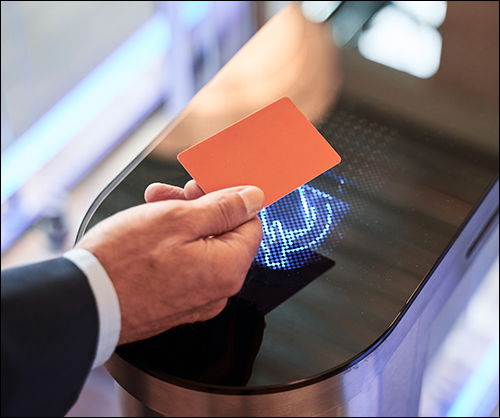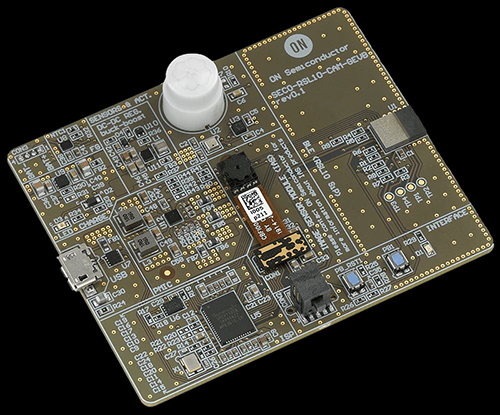Presented here are recent news announcements regarding the following organizations: HID Global, the Calypso Networks Association, GlobalFoundries, Silicon Labs, Senet, Avnet, Onsemi, Microsoft and the LoRa Alliance.
HID Global Offers SDK for NFC Mobile Ticketing
HID Global, a provider of trusted identity solutions, has announced a software development kit (SDK) that is certified for and compliant with the Calypso Networks Association (CNA)’s Host Card Emulation (HCE) standards for secure and convenient mobile ticketing on smartphones. This certification specifies how to protect ticket data stored in a mobile device’s wallet, thereby helping transport operators to fight fraud by preventing tickets from being duplicated, transferred or altered.
 “CNA is pleased to issue to the HID SOMA Atlas 4Digital SDK this first certificate of compliance with the security requirements established for the HCE Calypso mobile ticketing application,” said Philippe Vappereau, CNA’s CEO, in a prepared statement. “This solution offers transport operators flexible, fast and secure solutions that comply with the principles of the most stringent mobile security programs.”
“CNA is pleased to issue to the HID SOMA Atlas 4Digital SDK this first certificate of compliance with the security requirements established for the HCE Calypso mobile ticketing application,” said Philippe Vappereau, CNA’s CEO, in a prepared statement. “This solution offers transport operators flexible, fast and secure solutions that comply with the principles of the most stringent mobile security programs.”
Calypso, used by public transportation networks and cities worldwide, is an open standard for contactless ticketing applications in which Calypso cards and NFC mobile phones are employed, the company explains. The HCE standard extends CNA standards to mobile devices, while Calypso HCE Security Certification (CHSC) combines an evaluation methodology with stringent requirements for mobile security programs.
“Being at the forefront of achieving this certification underscores HID’s long-standing commitment to a security-by-design approach to building trusted identity solutions for our customers,” added Cesare Paciello, HID’s VP for events and mobility solutions, in the prepared statement. “Following HID’s world’s first certification for Calypso Light in 2018, this new industry-first milestone positions HID to continue leading the way for public transportation networks to implement next-generation automated fare collection solutions. In addition to delivering advanced security to safeguard against cloning, eavesdropping and other cyberthreats, the HID SOMA Atlas 4Digital SDK enables easier, more streamlined mobile ticketing.”
Mobile tickets powered by the HID SOMA Atlas 4Digital SDK can be used with Near Field Communication (NFC)-enabled smartphones, like paper or card-based tickets that meet the Calypso standard. The SDK enables transport operators and authorities to expand the range of devices customers can “tap to pay” for travel using Android-based smartphones and other NFC devices. Additionally, the company reports, passengers can use their mobile devices to add funds to Calypso transport cards, minimizing physical contact.
GlobalFoundries Unveils New IoT Solutions
GlobalFoundries (GF), a semiconductor manufacturing company, has announced a portfolio of features intended to improve chip design for smart mobile devices, data centers, the Internet of Things (IoT) and the automotive sector. According to the company, the semiconductor chip market is expected to double to more than $1 trillion by the end of the decade, with such chips used in appliances, thermostats, smartphones, cars, industrial equipment, medical devices and more.
“This past eighteen months have demonstrated what a semiconductor is and that they are vital to everything we do,” said Juan Cordovez, GlobalFoundries’ senior VP of sales, in a prepared statement. “This awareness and demand have catalyzed innovation in areas such as automotive and IoT, and this requires a new way of thinking. At GF, we are shattering the old paradigm of what innovation in semiconductor manufacturing means, by delivering differentiated solutions that are more intelligent and intuitive, more connected and secure, more powerful and energy-efficient to meet not only the demands of today but also for the future.”
The company has announced new feature sets for 5G and Wi-Fi 6/6e mobile phones and smart devices. GlobalFoundries’ RF-SOI sub 6 GHz solutions enable chip designers to provide a stronger 5G connection, GF reports, with fewer dead zones for talking, playing and streaming, and allowing more time on a single charge. Its FDX-RF solutions enable 5G mmWave devices to have more robust connections and more connected experiences, GF reports, while its Wi-Fi solutions include new features for RF and power amplifier functionality so that Wi-Fi 6 and 6e chip designers can provide a stronger connection for Wi-Fi-enabled products.
GF’s display solutions allow driver IC designers to enable variable refresh on OLED displays, in order to provide fast refresh rates for immersive gaming and moderated refresh rates for battery savings. Its audio solutions include a non-volatile memory option, and its imaging solutions allow designers to enable stacked CMOS image sensors with more than 200 megapixels of resolution, high dynamic range, slow-motion and lower power for smartphone cameras.
The firm’s photonics solutions are available on its new Silicon Photonics 45nm platform, which is on track for technology qualification by 2022, the company reports. The platform, combining RF CMOS and optical components, includes a micro ring resonator optical component in 300-millimeter wafer technology. GlobalFoundries is currently in discussions with customers and partners regarding the platform. GF’s microdisplay solutions for the IoT, meanwhile, are intended to improve process speed, reduce leakage and increase pixel driver functionality to enable smaller, lighter augmented reality glasses that can last longer on a single battery charge.
Silicon Labs Supports Zero Trust Security Model for IoT
Silicon Labs has announced what it calls Security Services to support IoT companies with Zero Trust security architectures designed to meet emerging cybersecurity standards and combat threats. The new offerings, featuring the company’s Secure Vault technologies, include its Custom Part Manufacturing Service (CPMS) for wireless systems-on-chip and modules. This secure provisioning service enables IoT developers to customize connected products with security features to safeguard hardware, software and ecosystems. The products include an SDK and support services for up to 10 years, covering an IoT product’s lifecycle.
According to Omdia‘s “Enterprise IoT 2021 Survey,” IoT security concerns grew by 13 percent in the past year among executives deploying IoT projects, Silicon Labs explains. High-profile breaches and hacks of critical infrastructure and household devices have raised quality concerns among consumers, the company notes, with malware IoT attacks increasing by 59 percent during the first six months of 2021, compared to last year.
“Developers face a daunting challenge driving innovation in IoT products for homes and industries while securing them against ever evolving threats,” said Matt Johnson, Silicon Labs’ president, in a prepared statement. “Trusted security hardware and software solutions are critical to their success. The days when simple password protection for authentication was sufficient are long gone. Our new Security Services make it easier for developers to implement custom hardware identities and trusted over-the-air security stack updates to reduce the risk of software, hardware and wireless access vulnerabilities.”
IoT companies can uses Security Services to protect against security breaches, intellectual property compromises and counterfeiting. The services support global cybersecurity and communication standards, the company reports, such as a U.S. executive order mandating the implementation of Zero Trust security architectures, as well as Matter and Wi-SUN requirements for secure identities. CPMS and the company’s Long-Term Software Development Kit Support Service (LTSSS) are intended to provide trusted and economical security services for IoT products.
A Web portal for CPMS allows developers to provision Silicon Labs’ wireless SoCs and modules with Secure Vault technology features, such as Secure Boot and Secure Debug, as well as a Secure OTA bootloader, customer specific keys, standard flash programming and custom identities for Zero Trust architectures. LTSSS reduces the need for expensive re-testing and re-certification activities due to code changes, the company reports, and ensures that Silicon Labs GSDK releases are maintained and supported for up to 10 years with security patches and bug fixes.
Senet Expands LWPAN Network Coverage for IoT Applications
Senet, a provider of cloud-based software and services platforms designed to enable connectivity and on-demand network build-outs for the IoT, has announced services and network coverage plans to provider broader access to low-power wide-area network (LPWAN) coverage for IoT applications in the United States. The announcement includes integration services that enable interconnectivity between Senet and third-party LoRaWAN networks, as well as wholesale network plans that let operator partners sell Senet coverage with carrier-grade service-level agreements.
Senet says its public LoRaWAN network covers more than 1,300 cities, serves a population of more than 55 million and processes millions of daily transactions. Its service offerings and business models for deploying and expanding IoT network coverage include its Radio Access Network (RAN) Partner Services, Operator Enablement Services and Low Power Wide Area Virtual Network (LVN). Through its Senet Extended Coverage offering, customers utilizing Senet’s public network now have expanded access to connectivity provided by contracted operator partners.
Senet Extended Coverage allows customers to use third-party operator partner networks in areas where the company’s technology is not yet deployed, or access-densified connectivity where Senet and its partners both offer coverage. The firm is offering connectivity plans that allow operator partners to sell wholesale, SLA-backed network coverage. According to Senet, these plans are geared toward LoRaWAN network operators that may not provide the service and support required by a segment of their customer base.
“As demand for LoRaWAN network services grows at a rapid pace, we are continuously innovating to expand coverage and maintain our position as the benchmark for reliable service and support,” said Bruce Chatterley, Senet’s CEO, in a prepared statement. “With our Extended Coverage offering and wholesale connectivity plans, customers benefit from greater and more reliable public low power wide area network access, which removes one of the most significant barriers to successfully scaling IoT deployments across cities, counties and communities.”
Avnet Connects Onsemi Smart Cameras to BLE-IoT Platform
As part of a collaborative effort to create a framework to help OEMs develop end-to-end IoT solutions, technology distributor and solutions provider Avnet has connected Onsemi‘s RSL10 Smart Shot Color Camera to the cloud via Avnet’s IoTConnect platform. This solution enables real-time images to be captured and transmitted to the cloud via Bluetooth Low Energy (BLE) so they can be interpreted to manage devices, set alerts and make decisions.
 “This solution is specifically developed for OEMs that are designing new products that should be IoT-enabled, or existing products that need to be retrofitted,” said Lou Lutostanski, Avnet’s VP of IoT, in a prepared statement. “We’re pleased to build on our collaborative success with the RSL10 Sensor Development Kit by launching a second project with Onsemi, furthering our shared commitment to help OEMs connect devices to the cloud via the IoTConnect platform.”
“This solution is specifically developed for OEMs that are designing new products that should be IoT-enabled, or existing products that need to be retrofitted,” said Lou Lutostanski, Avnet’s VP of IoT, in a prepared statement. “We’re pleased to build on our collaborative success with the RSL10 Sensor Development Kit by launching a second project with Onsemi, furthering our shared commitment to help OEMs connect devices to the cloud via the IoTConnect platform.”
“Our collaborative work provides OEMs with a proven vision-based device-to-cloud platform for rapid development of intelligent image monitoring solutions,” added Dave Priscak, Onsemi’s VP of applications engineering, in the prepared statement. “We focus specifically on always-on, battery-operated applications in inventory management, smart retail and factory automation. The RSL10 Smart Shot Camera offers an unprecedented multi-year battery life with the option for color or monochrome machine vision analytics.”
The camera provides imaging and BLE communication and connectivity, the company explains, while IoTConnect provides the means to link this information to the cloud so it can be interpreted and manipulated, and so learning can be performed via artificial intelligence. Customers can customize the system for their own proof-of-concept where vision is required, such as detecting objects, reading analog meters or checking inventory levels.
The collaboration, according to Avnet and Onsemi, is intended to allow OEMs to build products and experiences around those products. In addition, the solution will allow manufacturers to manage devices remotely by sending firmware updates and keeping software up to date. The companies offer pre-integrated hardware and software with a range of image sensor and connectivity options, and they also provide guidance on building the solution.
Microsoft Joins LoRa Alliance Board of Directors
The LoRa Alliance, an association of companies backing the open LoRaWAN standard for Internet of Things LPWANs, has announced that Tony Shakib, Microsoft‘s general manager and partner of Azure IoT engineering, has joined the organization’s board of directors. According to the LoRa Alliance, Microsoft’s participation is intended to strengthen LoRaWAN technology’s presence in the LPWAN market.
“Having Tony join the LoRa Alliance leadership will further accelerate market adoption of the LoRaWAN standard,” said Donna Moore, the LoRa Alliance’s CEO and chairwoman, in a prepared statement. “Microsoft joins an impressive roster of industry leaders who back the LoRaWAN standard and are committed to its development and the expansion of our ecosystem. Tony’s insight and guidance as an Alliance board director will strengthen and accelerate LoRaWAN end-to-end solutions and zero-touch deployments.”
“Microsoft has invested billions of dollars to enable customers to build digital twins of the physical world,” Shakib added in the prepared statement. “The digital twin enables customers to analyze, predict and control environments across industries, whether monitoring production lines, managing worker safety, optimizing supply chains or delighting retail customers. A critical link in these digital transformations is the connectivity fabric, and LoRaWAN has unique capabilities to help fulfill that vision. We are excited to join the LoRa Alliance and deepen our collaboration with members to help our customers succeed in IoT.”


